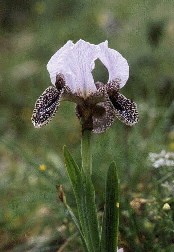Nature Reserve Management for Conservation of the Endangered Species Iris bismarckiana
Bosmat Segal, Yohay Carmel, Didi Kaplan1 and Moti Dolev1
1Nature and Parks Authority in Israel
View report (Hebrew) here.
Iris bismarckia na is one of the most beautiful flowers of Israel .It belongs to the Royal Irises (Iris section Oncocyclus) which comprise ten species in Israel and Jordan, all endemic with limited and distinct populations. Thanks to there unusual shape, size, and black shades, Royal Irises flowers are considered among the most beautiful blossoms in the world. Irises species are known through history and archeology until today, as a symbol of royalty and beauty. Today many of the iris lovers and cultivators are associated in societies all over the world, one of them is dedicated to the Oncocyclus and regalia sections: Aril Society International.
na is one of the most beautiful flowers of Israel .It belongs to the Royal Irises (Iris section Oncocyclus) which comprise ten species in Israel and Jordan, all endemic with limited and distinct populations. Thanks to there unusual shape, size, and black shades, Royal Irises flowers are considered among the most beautiful blossoms in the world. Irises species are known through history and archeology until today, as a symbol of royalty and beauty. Today many of the iris lovers and cultivators are associated in societies all over the world, one of them is dedicated to the Oncocyclus and regalia sections: Aril Society International.
Iris bismarckiana grows in limited areas in northern Israel. In the Nazareth region it is protected only in a small nature reserve, dedicated to conservation of this beautiful species. Unfortunately, wardens who followed the area in the past 20 years, report that the iris population is declining to such an extent, that its future is not ensured. The Israel nature & national parks protection authority, in conjunction with the ENVGIS, conduct a five years study, whose goals are to study the reasons for the decline in the population and find ways to encourage its recovery.
The nature reserve is divided into two main vegetation forms. The first (area A) is covered by prickly burnet, a common dwarf shrub, while the second (area B) is dominated by winter annuals. Only a few irises seem to grow within the prickly burnet in area A, a fact that suggests that the prickly burnet pushes the iris. Area B is characterized by a thick annuals cover. Many caterpillars who feed on the iris’ buds.
The prickly burnet, the thick annuals cover and the presence of the caterpillars are suspected in hindering the spread of the Iris population. It was determined to design experiments to isolate the influence of each of these factors. Another observation in the first studies year is a lack of seed setting.
Twelve representative plots were chosen within each of the vegetation forms. The Iris population in each plot was mapped using a satellite navigation device (GPS-RPK). This system enables mapping of objects with accuracy of better than five cm in 95% of the cases. Errors of less than one cm were achived and we expect that this accurate mapping will enable tracking the changes in the population in the following years.
Several treatments were chosen to eliminate the influence of the detractors. In area A the Prickly Burnet cover was minimized in four plots by pruning and in other four plots by burning the Prickly Burnet bushes. The remaining plots are used as control. In area B the annuals cover was minimized, and the caterpillars were destroyed using the appropriate poisons. The four remaining plots were kept as control. To encourage seed setting, artificial pollination will be carried out. The amount of setting in artificially pollinated flowers will be compared to the corresponding amounts in control flowers.
Reports by the reserve wardens point to the Prickly Burnet as the main suspect in the decline of the Iris population. The variation in the Prickly Burnet cover in the last decadeds will be examined using air photos to verify these suspicions. The Prickly Burnet is seen in the photos in darker hues and we will use computerized process to automatically calculate its cover in air photos from various years.
The various treatments, and tracking variations in the Iris population in the plots is planned for the next five years. We hope to see significant improvement in the treated plots that will help in the design of an optimal management of the reserve, and encouragement of the Iris populations elsewhere.
